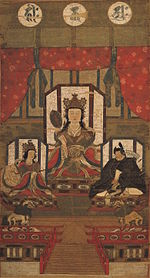| Shirayama Hime Shrine 白山比咩神社 | |
|---|---|
 Honden of Shirayama Hime Shrine Honden of Shirayama Hime Shrine
| |
| Religion | |
| Affiliation | Shinto |
| Deity | Shirayama Hime=Kukurihime no Kami Izanagi Izanami |
| Festival | May 6 |
| Location | |
| Location | 105-1,Ni,Sannomiya-machi, Hakusan Ishikawa Prefecture 920-2114 |
  | |
| Geographic coordinates | 36°26′5.5″N 136°38′10.1″E / 36.434861°N 136.636139°E / 36.434861; 136.636139 |
| Website | |
| www | |
Shirayamahime Jinja (白山比咩神社) is a Shinto shrine in the Sannomiyamachi neighborhood of the city of Hakusan in Ishikawa Prefecture, Japan. It is the ichinomiya of former Kaga Province. The main festival of the shrine is held annually on May 6. It is the head shrine of approximately 2000 "Hakusan Jinja" across Japan. Though read differently, "Shirayama" and "Hakusan" use the same characters (白山) in Japanese.
Enshrined kami
The kami enshrined at Shirayamahime Jinja are:
- Shirayamahime-no-Okami (白山比咩大神), also known as Kukurihime, the deified Hakusan volcano
- Izanagi-no-Mikoto (伊邪那岐尊), the creator god
- Izanami-no-Mikoto (伊弉冉尊), the creator goddess
History
The Shirayamahime Jinja is located at the foot of 2702 meter Mount Hakusan, a sacred mountain on the border of Ishikawa and Gifu Prefectures. The shrine consists of the "Hakusan Hongū" or Shimo-Hakusan, located at the foot of the mountain, and the "Oku-no-miya" located at the summit of the Gozengamine peak of the mountain. The origins of Shirayamahime Jinja are unknown. The mountain has been an object of worship from prehistoric times, and one of the Three Holy Mountains of Japan. Although there is no documentary evidence, the shrine claims that it was first established by the legendary Kofun period Emperor Sujin (reigned 97 BC – 30 BC) and was rebuilt in 716 by Empress Genshō. The shugendō monk Taichō is said to have been the first person to reach the summit in 717, and to have built a chapel there. However, the first appearance of the shrine in historical documentation is an entry date 853 in the Nihon Montoku Tennō Jitsuroku, in which it was granted third court rank. At some point in the mid-Heian period, the shrine came to be regarded as the ichinomiya of the province. During the Kamakura and early Muromachi periods the shrine prospered greatly as in collaboration with Zen Buddhism, Hakusan shrines were established at many locations around the country. However, this prosperity came to an end with the Kaga ikki in 1455. During this rebellion, the shrine lost its estates and revenues and in 1480 the shrine, which was located on the banks of the Tedori River at the time, was destroyed by fire. It remained in ruins for over a century.
The shrine was restored by Maeda Toshiie, daimyō of Kaga Domain under the Tokugawa shogunate in the early Edo period, and continued to grow and prosper with the patronage of the Maeda clan until the Meiji Restoration. During the Meiji period era of State Shinto, the shrine was designated as a National shrine, 2nd rank (国幣中社, kokuhei-chūsha) under the Modern system of ranked Shinto shrines.
See also
References
- Shibuya, Nobuhiro (2015). Shokoku jinja Ichinomiya Ninomiya San'nomiya (in Japanese). Yamakawa shuppansha. ISBN 978-4634150867.
- Shirayama Hime Shrine history compilation committee edition "Hakusan Faith illustration" (Hakusan Hime Shrine, 2003)
- "Place name of Ishikawa Prefecture, Japanese historical place name system" ( Heibonsha ) Introduction Hakusan Paragraph, Hakusan Hiraku Shrine of Tsururai Town, Ishikawa District
- Shinto Encyclopedia Volume One piece 264 (original 455 pages)
- Encyclopedia of the World Goddess pages 42-43 "Kukurihime Kikurihime"
- Emperor Keishinkai Digital Collection, National Diet Library "Kokuzai Chusha Hakusanjo Shrine" "National Famous Shrine Photographs," Imperial Keishinkai, December 1922 .
- Morokami Divine Festival Deity Dictionary pp. 446-447 "Shirayama Hime Shrine"
- # Yama no reiryoku (Mountain spirit power) pp. 177-178 "Hakusan that Jomon people also danced to"
- UNESCO Biosphere Reserve Information: Mount Hakusan. UNESCO. Accessed May 16, 2008.. Archived June 6, 2011, at the Wayback Machine
- Taichō Kashō Denki Archived 2010-03-04 at the Wayback Machine. Katsuyama Kyōdoshi Kenkyūkai. Accessed November 17, 2010.
- Yoshiki, Emi (2007). Zenkoku 'Ichinomiya' tettei gaido (in Japanese). PHP Institute. ISBN 978-4569669304.
External links
[REDACTED] Media related to Shirayamahime-jinja at Wikimedia Commons
| Shinto shrines | |||||||||||||||||||||||||||||
|---|---|---|---|---|---|---|---|---|---|---|---|---|---|---|---|---|---|---|---|---|---|---|---|---|---|---|---|---|---|
| |||||||||||||||||||||||||||||
| |||||||||||||||||||||||||||||
This article relating to Shinto is a stub. You can help Misplaced Pages by expanding it. |
This article about a Japanese religious building or structure is a stub. You can help Misplaced Pages by expanding it. |
| Shirayama Hime Faith | ||
|---|---|---|
| Main Deities |
|  |
| Head Shrines | ||
| Branch shrines | ||